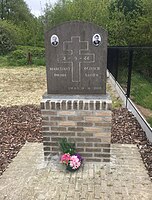
French Resistance
The French Resistance (French: La Résistance) was a collection of groups that fought the Nazi occupation and the collaborationist Vichy régime in France during the Second World War. Resistance cells were small groups of armed men and women (called the Maquis in rural areas)[2][3] who conducted guerrilla warfare and published underground newspapers. They also provided first-hand intelligence information, and escape networks that helped Allied soldiers and airmen trapped behind Axis lines. The Resistance's men and women came from many parts of French society, including émigrés, academics, students, aristocrats, conservative Roman Catholics (including clergy), Protestants, Jews, Muslims, liberals, anarchists, communists, and some fascists. The proportion of French people who participated in organized resistance has been estimated at from one to three percent of the total population.[4]
"La Résistance" redirects here. For other uses, see La Résistance (disambiguation).
The French Resistance played a significant role in facilitating the Allies' rapid advance through France following the invasion of Normandy on 6 June 1944. Members provided military intelligence on German defences known as the Atlantic Wall, and on Wehrmacht deployments and orders of battle for the Allies' invasion of Provence on 15 August. The Resistance also planned, coordinated, and executed sabotage acts on electrical power grids, transport facilities, and telecommunications networks.[5][6] The Resistance's work was politically and morally important to France during and after the German occupation. The actions of the Resistance contrasted with the collaborationism of the Vichy régime.[7][8]
After the Allied landings in Normandy and Provence, the paramilitary components of the Resistance formed a hierarchy of operational units known as the French Forces of the Interior (FFI) with around 100,000 fighters in June 1944. By October 1944, the FFI had grown to 400,000 members.[9] Although the amalgamation of the FFI was sometimes fraught with political difficulties, it was ultimately successful and allowed France to rebuild the fourth-largest army in the European theatre (1.2 million men) by VE Day in May 1945.[10]
Terminology[edit]
Charles de Gaulle spoke of "French resistance" in his broadcast on 18 June 1940.[265] English-language use of the phrase "the Resistance" in reference to French anti-Axis activity dates back to at least 1944.[266] Boris Kovalyov has stated that the Resistance movement in France and its name originated among White Movement Russian émigrés.[267] The Russian Boris Vildé co-founded one of the first anti-occupation groups, and in December 1940 started co-publishing the underground newspaper Résistance.
Popular culture[edit]
The Resistance features in the Kevin Doherty novels Villa Normandie (Endeavour Press, 2015), which depicts a female Resistance cell leader as the novel's main character, Charlie's War (Endeavour Press, 2016), and Landscape of Shadows (Oceanview Publishing, 2022), and also in films such as the 1964 film The Train, based on fact about the Resistance's efforts to prevent a train carrying looted French art from getting to Germany, and the 2011 film 15 Lads, about a group of young Resistance fighters,[372] inspired by the real-life experiences of director Romain Cogitore's grandfather, Antoine Cogitore, as a Resistance fighter in the maquis of Grande Chartreuse when he was a teenager.[373]
In television, the series Un village français (English: A French Village) tells the extended story of a community of resistance members and the harsh realities that such a group faced during the entirety of the French occupation, and Resistance, created by TF1 in France (as Résistance), is a drama set in German-occupied Paris in 1940 depicting the lives of students and teachers within the Resistance, loosely based on the activities of the Groupe du musée de l'Homme. 'Allo 'Allo!, a British sitcom featuring Resistance activities, was conceived as a parody of the earlier BBC drama series Secret Army,[374] and a number of characters in the Star Trek television franchise are members of the maquis.
Emmanuel d'Astier de La Vigerie, credited as Bernard, wrote the original French lyrics of Anna Marly's 1943 song "La Complainte du partisan", which later gained worldwide popularity as "The Partisan" with English lyrics adapted by Hy Zaret. The song describes the trials of a Resistance member from their perspective. Many artists have released versions of the song, in many languages, with the most well-known release being by Leonard Cohen in 1969.

